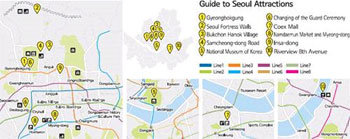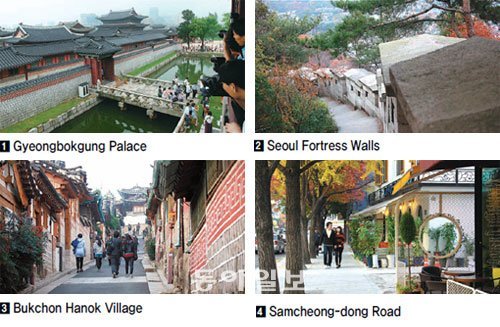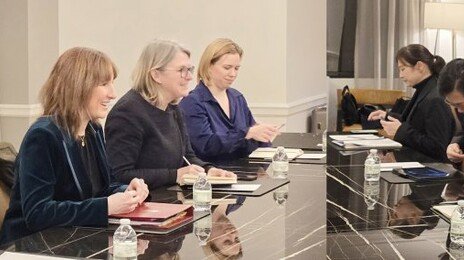공유하기
[G20 SEOUL SUMMIT 2010]Capital Attractions: The Best of Seoul
- 동아일보
-
입력 2010년 11월 12일 03시 00분
글자크기 설정

□1 Gyeongbokgung Palace

Hours: 9am - 5pm. Closed Tuesdays. Subway: Gyeongbokgung Station, Line 3.
□2 Seoul Fortress Walls
Hours: 10am - 3 pm. Closed Mondays. Free admission. Note: Identification card required at entrance for security reasons. There are three entrances; see homepage for details. www.bukak.or.kr
□3 Bukchon Hanok Village

□4 Samcheong-dong Road
Samcheong-dong, to the north and east of Gyeongbokgung, is a winding, tree-lined road that climbs up Mount Bukak, ending at the entrance to Samcheong Park. Samcheong-dong is perhaps the capital’s prettiest neigbhorhood: A low-rise district of small museums, restaurants, coffee shops, wine bars and traditional tea houses, many built inside renovated hanoks. Try the persimmon punch, sweet rice drink or sweet red bean porridge at the “Second Most Tasty House in Seoul,” a traditional tea shop.
Subway: Walk from Gyeongbokgung Station or Anguk Station (Exit 1), both on Line 3.

Hours: Open late (until 9pm) on Wednesdays and Saturdays. Subway: 150 meters from Exit 2, Ichon Station, Line 4. www.museum.go.kr
□6 Changing of the Guard
Changing of the Guard ceremonies, scrupulously researched recreations of medieval military drills, are mounted in front of the Gyeongbokgung and Deoksugung palaces several times each day. Each parade features 70-80 guardsmen in traditional attire, armed with swords, spears and other medieval weaponry. Adding aural ambience, a traditional military band performs after each ceremony, then lines up in front of the gates to guard the palaces, where the guardsmen can be photographed with tourists.
Hours: Gyeongbokgung Palace: Everyday except Tuesdays, every hour between 10am and 4pm. Deoksugung Palace: Everyday except Monday; 11am; 2pm; 3:30pm. No ceremony during rain. Subway: City Hall Station, Line 1 (Deoksugung Palace); Gyeongbokgung Station, Line 3 (Gyeongbokgung Palace)
□7 Coex Mall
Coex, the site of the G20 summit, is Korea’s largest convention center. It comprises a department store, two hotels, a concert hall, a city airport terminal, the Trade Center building and the ASEM Tower building. The mall below accommodates a kimchi museum, a multiplex cinema and an aquarium; the mall is also home to 84 eateries and 176 stores. Visit the food court if you want to try a variety of reasonably priced Korean and international foods; you will see the chefs at work in their open kitchens.
Subway: Samseong Station, Line 2.
□8 Namdaemun Market and Myeong-dong
Namdaemun Market and Myeong-dong in central Seoul are the capital’s “then and now” shopping districts. Namdaemun, a labyrinthine street market which dates back 600 years, exudes an earthy, folksy ambience. Things liven up after 5pm when vendors fill the alleys, haggling fills the air and goods fly off the racks at knock-down prices. Myeong-dong (also spelled Myung-dong), just ten minutes away on foot, is a modern, pedestrianized shopping district, packed with boutiques, restaurants and department stores.
Subway: Hoehyeon Station (Nam-daemun Market) and Myeong-dong Station, Line 4. www.indm.net www.myungdong.co.kr
□9 Insa-dong
Insa-dong is Seoul’s premier arts, crafts and antique district. Antique shops, art galleries, restaurants, bars and tea shops line its main street; more are hidden away in the maze-like alleys sprouting off it. Insa-dong is the place for souvenirs such as traditional Korean paper, fans, ink stands, screens and porcelain, at prices that range from the cheap to the ridiculous. A plate of scallion pancakes with a pot of makgeolli - a popular rice brew - at a restaurant in one of the alleys, or alternatively, a cup of ginger or ginseng tea at one of the district’s many tea houses, will break up the shopping and window-shopping.
Subway: Anguk Station. Line 3. www.insadong.info
□10 Riverview 8th Avenue
The Han River, which bisects the capital city into north and south, is a broad watercourse lined with high-rise architecture and spanned by foot, road and rail bridges. Several observatories have recently been installed along the river to view the bridges, many of which are floodlit at night. Riverview 8th Avenue is one such, attached to the Gwangjin Bridge. The observatory, which appears to float in the air, provides wide vistas of the river and its surroundings through its expansive windows and part-glass floor. Live jazz plays here during the weekends.
Hours: Open till 10pm in November. Subway: Chunho Station, Line 5; Gwangnaru Station, Line 5. Website: www.riverview8.co.kr Tel: 02-476-0722
By Cho Seung-ha
summer@donga.com
-
- 좋아요
- 0개
-
- 슬퍼요
- 0개
-
- 화나요
- 0개



댓글 0